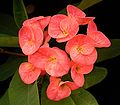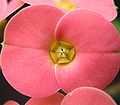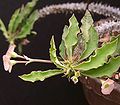Christ thorn (Euphorbia)
| Christ thorn | ||||||||||||
|---|---|---|---|---|---|---|---|---|---|---|---|---|

Christ thorn ( Euphorbia milii var.milii ) |
||||||||||||
| Systematics | ||||||||||||
|
||||||||||||
| Scientific name | ||||||||||||
| Euphorbia milii | ||||||||||||
| Des Moul. |
The Christ thorn ( Euphorbia milii , Syn . : Euphorbia bojeri Hook. , Euphorbia splendens Bojer ex Hook. , Euphorbia splendens var. Bojeri (Hook.) Leandri ) is a species in the genus Spurge ( Euphorbia ) from the family of the Spurge Family (Euphorbiaceae) .
Origin of name
The Christ thorn got its German name because its thorny branches are reminiscent of the biblical crown of thorns of Jesus . However, since the species was only imported from Madagascar in the 19th century and Madagascar was practically inaccessible at the turn of the century , its sometimes still suspected use as a biblical crown of thorns can be completely ruled out.
The scientific name is reminiscent of Baron Pierre-Bernard Milius (1773-1829), who was the French governor of the Bourbon Island (now Réunion ). In 1821 he sent three plants of the then unknown species to the Botanical Garden of Bordeaux . Of these very plants, Charles des Moulins described and published the species in 1826, which he named in honor of Milius.
Description and distribution of the natural species
It is a succulent , thorny and leafy shrub . Within the genus Euphorbia it belongs with more than 50 other species to the subgenus Euphorbia , section Goniostema , in which the species have paired and mostly strikingly colored bracts under the cyathia , which imitate the missing petals of the greatly reduced flowers . These special bracts are called " cyathophylls ". Like all euphorbias, the Christ thorn also contains a toxic and skin-irritating milk juice .
The number of chromosomes is 2n = 40.
Varieties
One can differentiate between the following varieties:
- Euphorbia milii Desmoul. var. milii grows in western Madagascar and forms richly branched shrubs that reach heights of up to 1.5 meters. The twigs are up to 1 cm in diameter. The dark green, lanceolate leaves are up to 4 cm long and 2 cm wide. The stipule spines (stipules) are paired around the base of the leaves and are 1 to 2 cm long. The inflorescence stalks are forked two to three times and carry small cyathia with spread out, about 6 × 8 mm², mostly red (rarely yellow) cyathophylls.
- Euphorbia milii var. Bevilaniensis ( Croizat ) Ursch & Leandri (1955) grows in southern Madagascar (between Anosy and Adroy District) on gneiss rocks in forests and differs through inverted triangular leaves, shoots about 5 mm in diameter and up to 1 cm long thorns.
- Euphorbia milii var. Hislopii ( NEBr. ) Ursch & Leandri (1955) grows in central Madagascar and is only known in culture (as a hedge plant). Overall, it is coarser and more robust and forms up to 2 m tall bushes, up to 2 cm thick shoots, up to 15 × 5 cm² leaves and up to sixfold bifurcated stems.
- Euphorbia milii var. Imperatae (Leandri) Ursch & Leandri (1955) grows in the coastal forest of eastern Madagascar and differs through only 50 cm large shrubs with only 5 mm thick branches, egg-shaped leaves up to 10 × 7 cm² and only one to double bifurcated, short inflorescence stems.
- Euphorbia milii var. Longifolia Rauh (1967) grows on granite rocks in central Madagascar and differs through predominantly basal branching, slack twigs up to 2 cm thick, linear leaves up to 20 × 1 cm² and yellow cyathophylls.
- Euphorbia milii var. Roseana Marn.-Lap. (1962) grows in forests in central to southern Madagascar (near Sakaraha ) and differs through fairly upright twigs, lanceolate leaves up to 9 × 2.5 cm², double-bifurcated inflorescent stalks and whitish yellow cyathophylls.
- Euphorbia milii var. Splendens ( Bojer ex Hook. ) Ursch & Leandri (1955) grows in central Madagascar and differs through up to 2 m large shrubs, light green leaves, numerous, basal thorns and sometimes yellow cyathophylls.
- Euphorbia milii var. Tananarivae (Leandri) Ursch & Leandri (1955) grows in central Madagascar and is only known in culture (as a hedge plant). It differs through up to 2 m large bushes, up to 3 cm thick branches and up to 8 × 10 mm² large, yellow, red edged cyathophylls.
- Euphorbia milii var. Tenuispina Rauh & Razaf. (1991) grows in southern Madagascar (in the mountains around Ihosy and Isalo ) and differs through a thickened, bulbous trunk and very slender thorns.
- Euphorbia milii var. Tulearensis Ursch & Leandri (1955) grows in southwestern Madagascar (near Toliara ) and differs through smaller, up to 1 cm long thorns and bright red cyathophylls.
- Euphorbia milii var. Vulcanii (Leandri) Ursch & Leandri (1955) grows in central to southern Madagascar (between Betafo and Ambatofinandrahana ) and differs through bluish green leaves up to 20 × 5 cm², about 1 cm long, in about ten rows arranged thorns and long, four-forked inflorescence stalks.
Almost all varieties are only available in specialist shops. Only Euphorbia milii var. Splendens is also offered in flower shops and hardware stores. All varieties can be kept as house plants and need a very bright location without too much direct sun and temperatures above about 12 to 15 ° C all year round. Suitable locations are, for example, window sills facing south. A summer outdoor stay, e.g. B. in the light shade of a tree, leads to stocky growing plants and strongly colored cyathophylls.
All varieties only grow seasonally and need a drought in our winter. During this time, when the watering is so weak that the root ball does not dry out completely, the plants lose almost all of their leaves. Healthy plants can tolerate a completely dry overwintering, but then have tarnishing problems in spring when they first have to form new roots. If the plants are watered over the winter, they tend to perish , become susceptible to disease and sometimes rot quickly.
Animal pests are extremely rare because of the poisonous milky sap. Powdery mildew can occur if the humidity is too high .
Hybrids
Most of the commercially available cultivated forms are based on hybrids of Euphorbia milii with Euphorbia lophogona Lam. 1788 back.
Hybrids of Euphorbia milii and Euphorbia lophogona often develop accidentally when the plants are close together in collections. The first reports on such hybrids come from Franklin Crosby from Malibu, California, USA (1960) and Harry Hall from Kirstenbosch, South Africa (1961). Known as 'Californian hybrids', these cultivars have interrupted rows of thorns, which represent a compromise between the paired spines of E. milii and the continuous rows of thorns of E. lophogona .
The natural hybrids between Euphorbia milii and Euphorbia lophogona found by Werner Rauh , who was a professor at the University of Heidelberg, about 50 km north of Tolagnaro (Fort Dauphin) represent another group known as 'Heidelberg hybrids'. Rauh formally described it as Euphorbia × lomi , where the first syllable of the parental name ( lo phogona, mi lii) resulted in the new name. Compared to the Californian hybrids, the Heidelberg hybrids have thinner stems and smaller but thicker leaves.
A third group are the hybrids from Thailand . Their origin is unknown, but because of their particularly large cyathophylls, one of the parents is likely to be E. milii var. Tananarivae . In Thailand and other Asian countries, the varieties known as 'Poysean hybrids' are considered lucky charms, which led to much zeal for breeding and the widespread use of the plants.
All of these hybrids are ideal houseplants and like a light, partially shaded spot on the window sill. Like the natural species, they need at least 12 to 15 ° in winter, but with sufficient irrigation they have no problems standing close to radiators. They tolerate and like to be watered in winter, keep their leaves for several years and bloom almost all year round. Powdery mildew occurs less often than with the natural species, but can occur with high humidity.
Since all species of the Goniostema section can be crossed with one another , hybrids of Euphorbia milii with a parent other than Euphorbia lophogona can now also be found on the market . A hybrid Euphorbia milii × Euphorbia decaryi var. Spirosticha from Nathan Wong of the Honolulu Botanical Gardens was first offered in 1999 in Grigsby's catalog (USA) and was named 'Nat Wong' in honor of the creator Euphorbia . Another cross of Nathan Wong, Euphorbia milii × Euphorbia moratii , impresses with its unusually marbled leaves and is called Euphorbia 'Hawaii'. Euphorbia 'Honkeytonk', a hybrid Euphorbia milii × Euphorbia didiereoides with orange-colored cyathophylls, has only recently been on the market .
Toxicity
According to a study by the Research Center for Environment and Health , the diterpene esters contained in the sap of Euphorbia lomi and Euphorbia leuconeura should be able to act as tumor promoters by activating cancer cells in conjunction with another carcinogenic substance. Therefore, when handling these plants, you should make sure that no milky sap gets on the skin.
gallery
Varieties
Hybrids
literature
- Charles Robert Alexandre Des Moulins: DESCRIPTION D'UNE NOUVELLE ESPECE D'EUPHORBE , Bull. Hist. Nat. Soc. Linn. Bordeaux 1: 27-30, t. 1, 1826
- Eugène Ursch & Jacques Désiré Leandri: Les Euphorbes Malgaches Epineuses et Charnues du Jardin Botanique de Tsimbazaza : 144-154, 1954
- Werner Rauh : Euphorbia x lomi , Kakteen und other succulents 30 (11): 257, 1979
- Stephen Jankalski: Euphorbia x lomi , Cactus & Succulent Journal (US) 72 (4): 203, 2000
- Bob Smoley: Giant-flowered Euphorbia milii hybrids , Cactus & Succulent Journal (US) 72 (1): 198-201, 2000
- Leonard Eric Newton: The type of Euphorbia milii Des Moulins , Cactus & Succulent Journal (US) 72 (4): 206-207, 2000
Individual evidence
- ↑ Euphorbia milii at Tropicos.org. In: IPCN Chromosome Reports . Missouri Botanical Garden, St. Louis.



















